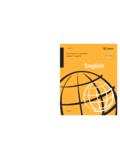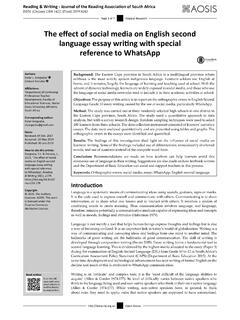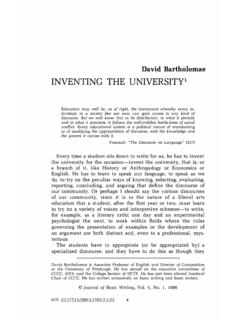Transcription of The Use of Information and Communication Technology (ICT ...
1 english Language Teaching; Vol. 6, No. 7; 2013 ISSN 1916-4742 E-ISSN 1916-4750 Published by Canadian Center of Science and Education 1 The Use of Information and Communication Technology (ICT) in Teaching ESL Writing Skills Melor Md Yunus1, Norazah Nordin1, Hadi Salehi1, 2, Mohamed Amin Embi1 & Zeinab Salehi2 1 Faculty of Education, Universiti Kebangsaan Malaysia (UKM), 43600 Bangi, Selangor, Malaysia 2 Faculty of Literature and Humanities, Najafabad Branch, Islamic Azad University, Najafabad, Isfahan, Iran Correspondence: Hadi Salehi, Faculty of Literature and Humanities, Najafabad Branch, Islamic Azad University, Najafabad, Isfahan, Iran.
2 Tel: 60-176-538-260. E-mail: Received: April 14, 2013 Accepted: May 10, 2013 Online Published: June 3, 2013 URL: Abstract Despite the existence of many studies showing positive effects of using Information and Communication Technology (ICT) in the teaching and learning process in general, the use of ICT in teaching writing skills in english as a Second Language (ESL) classrooms is still not very encouraging. This study attempts to seek findings on the use of ICT in the teaching of ESL writing skills in Malaysian secondary schools. This paper just reports one part of the findings obtained from a big project which was conducted in Malaysian secondary schools in five areas of Malaysia.
3 This study focuses solely on the data collected from four english teachers in a secondary school in Kuala Lumpur who were interviewed by the researcher. This study revealed that the use of ICT in the teaching of ESL writing was very low. Advantages of using ICT were reported to be attracting students attention, facilitating students learning process, helping to improve students vocabulary and promoting meaningful learning. Disadvantages found included the difficult class control, distraction and the students tendency to use short forms in their writing. It was also revealed that teachers are generally weak in managing problems and planning activities involving the use of ICT in the teaching of ESL writing.
4 The results of this study are hoped to provide insights to the Ministry of Education in Malaysia to improve the low use of ICT in teaching ESL writing skills. Keywords: Information and Communication Technology (ICT), english as a Second Language (ESL), Writing, Teaching, Learning 1. Introduction Since the implementation of the first computer system in the 1960s, different measures and plans have been developed to increase the integration of Information and Communications Technology (ICT) in all educational fields (Nordin, Embi & Yunus, 2010; Nordin et al, 2010; Salehi & Salehi, 2012; Ynus, Salehi & Chenzi, 2012). The notion of ICT in educational fields refers to systems that enable gathering, manipulation, management, access, and Communication of Information in different forms.
5 The Ministry of Education in Malaysia has developed three major plans for using ICT in education (Ministry of Education Malaysia, 2003). The first plan emphasizes that ICT should be for all students, meaning that ICT is utilized as an enabler to decease the existing digital gap between the schools. The second plan refers to the function of ICT in education as a teaching and learning tool. This plan also emphasizes the use of ICT as an educational tool for obtaining and Communication Information . The third plan stresses on ICT usage to enhance productivity, effectiveness and efficiency of the management system. In this plan, ICT can be greatly utilized to mechanize and update work processes such as financial management, lesson planning and management of Information systems.
6 This study specifically aims to investigate the perceptions of Malaysian secondary school english teachers about the use of ICT in teaching english as a Second Language (ESL) writing skills. 2. Literature Review Writing skill which is an important aspect of language learning refers to the process of encoding the words (Floyd et al., 2007). Although ICT can be regarded as an important tool to enhance the teaching of writing skills (Melor Md Yunus, 2007), there are some disadvantages in terms of using this tool. Moreover, teachers have to take note on the matters in planning the activities involving the use of ICT and managing problems arising from the activities planned.
7 The following sub-sections discuss an example of ICT tools to show the advantages and disadvantages of english Language Teaching Vol. 6, No. 7; 2013 2 using ICT in teaching writing skills. Moreover, some of the issues involved in managing problems and planning activities using ICT tools have been discussed and reviewed. Advantages and Disadvantages of Using ICT in Teaching ESL Writing Skills One of the popular tools commonly adapted in the teaching of writing skills is the use of blogs. According to Kelly & Safford (2009), blogging provides a real-world digital medium for Communication . It is a multi-dimensional tool that not only offers a container for writing but also has the possibility of multiple audiences and access points (p.)
8 119). In their research on the effectiveness of using the online writing approach in teaching writing, Kelly & Safford (2009) conducted a research project in 6 different classes during 2006 Soccer World Cup to analyze how the students employed complicated sentence structures in their writing on a soccer weblog. They explored how the effect of a short-term, popular, worldwide event and an online platform for Communication provided an opportunity of writing skill improvement where students started to use complex sentence structures. This research shows positive findings in terms of the students interest in presenting ideas and responding to their classmates ideas by commenting on the blog.
9 Similarly, Holder (2006) claimed that online blogs let bloggers get feedback from more than one person, and this kind of peer feedback is more effective than traditional self-correction. Moreover, Lenhart et al. (2008) concluded that blogs are common platforms for teenagers to express their viewpoints, and there is sufficient evidence to support that students having personal blogs tend to be prolific writers in the school. In fact, by using blogs in the teaching of writing, the positive interactivity for the teaching and learning of sentence grammar will be increased. Research on the use of ICT tools in ESL writing classroom has shown that ICT makes a supportive and encouraging environment for the students to increase their writing skills in terms of quality and quantity (Lam & Pennington, 1995; Bialo & Sivin-Kachala, 1996; Goldberg, Russell & Cook, 2003; Fidaoui, Bahous & Bacha, 2010).
10 On the other hand, the literature suggests that there are some disadvantages in terms of using ICT in the teaching of writing skills (Salehi & Salehi, 2011; Yunus & Salehi, 2012). The use of computer Technology could cause the lackadaisical attitude among students whereby they will not take their work seriously. Moreover, ICT tools distract students attention in the classroom and provide a tendency for the students to use short forms and informal abbreviations in their writing tasks (Yunus et al, 2013). The presence of ICT tools in the classroom makes the students negatively involved during the class time and makes the class control difficult for the teachers (Yunus et al, 2013).














